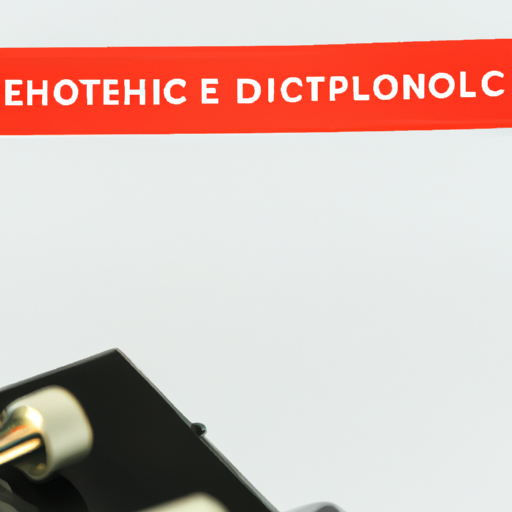

Optoelectronics is a branch of electronics that deals with the study and application of electronic devices that interact with light. These devices use light to perform various functions such as communication, sensing, and display. Optoelectronics has become an essential technology in various industries, including telecommunications, healthcare, and consumer electronics. In this article, we will explore the product features of optoelectronics and how they are revolutionizing the way we interact with technology.

Another important product feature of optoelectronics is its ability to sense and detect light. Optoelectronic sensors are used in a wide range of applications, from automotive safety systems to environmental monitoring. These sensors can detect changes in light intensity, color, and wavelength, allowing them to measure various parameters such as temperature, pressure, and humidity. Optoelectronic sensors are also used in medical devices for monitoring vital signs and detecting diseases.
Optoelectronics also plays a crucial role in display technology. Light-emitting diodes (LEDs) and organic light-emitting diodes (OLEDs) are commonly used in displays for smartphones, TVs, and other electronic devices. These displays offer high brightness, contrast, and energy efficiency compared to traditional liquid crystal displays (LCDs). Optoelectronic displays are also flexible and can be curved or folded, making them ideal for wearable devices and other innovative applications.
In addition to communication, sensing, and display, optoelectronics is also used in imaging and photography. Charge-coupled devices (CCDs) and complementary metal-oxide-semiconductor (CMOS) sensors are commonly used in digital cameras and medical imaging devices. These sensors convert light into electrical signals, allowing for the capture of high-resolution images and videos. Optoelectronic imaging systems are also used in security cameras, surveillance systems, and autonomous vehicles for capturing and processing visual information.
Optoelectronics is also making significant advancements in the field of energy efficiency and renewable energy. Solar cells, also known as photovoltaic cells, convert sunlight into electricity using the photovoltaic effect. These cells are made of semiconductor materials that absorb light and generate an electric current. Optoelectronic devices such as solar panels are used to harness solar energy for powering homes, businesses, and other applications. Optoelectronics is also used in light-emitting diodes (LEDs) for energy-efficient lighting solutions that consume less power and last longer than traditional incandescent bulbs.
Overall, the product features of optoelectronics are diverse and versatile, making it a key technology in various industries. From communication and sensing to display and imaging, optoelectronics is revolutionizing the way we interact with technology. As the demand for faster, more efficient, and environmentally friendly devices continues to grow, optoelectronics will play an increasingly important role in shaping the future of electronics. With ongoing research and development in this field, we can expect to see even more innovative products and applications of optoelectronics in the years to come.
Optoelectronics is a branch of electronics that deals with the study and application of electronic devices that interact with light. These devices use light to perform various functions such as communication, sensing, and display. Optoelectronics has become an essential technology in various industries, including telecommunications, healthcare, and consumer electronics. In this article, we will explore the product features of optoelectronics and how they are revolutionizing the way we interact with technology.

Another important product feature of optoelectronics is its ability to sense and detect light. Optoelectronic sensors are used in a wide range of applications, from automotive safety systems to environmental monitoring. These sensors can detect changes in light intensity, color, and wavelength, allowing them to measure various parameters such as temperature, pressure, and humidity. Optoelectronic sensors are also used in medical devices for monitoring vital signs and detecting diseases.
Optoelectronics also plays a crucial role in display technology. Light-emitting diodes (LEDs) and organic light-emitting diodes (OLEDs) are commonly used in displays for smartphones, TVs, and other electronic devices. These displays offer high brightness, contrast, and energy efficiency compared to traditional liquid crystal displays (LCDs). Optoelectronic displays are also flexible and can be curved or folded, making them ideal for wearable devices and other innovative applications.
In addition to communication, sensing, and display, optoelectronics is also used in imaging and photography. Charge-coupled devices (CCDs) and complementary metal-oxide-semiconductor (CMOS) sensors are commonly used in digital cameras and medical imaging devices. These sensors convert light into electrical signals, allowing for the capture of high-resolution images and videos. Optoelectronic imaging systems are also used in security cameras, surveillance systems, and autonomous vehicles for capturing and processing visual information.
Optoelectronics is also making significant advancements in the field of energy efficiency and renewable energy. Solar cells, also known as photovoltaic cells, convert sunlight into electricity using the photovoltaic effect. These cells are made of semiconductor materials that absorb light and generate an electric current. Optoelectronic devices such as solar panels are used to harness solar energy for powering homes, businesses, and other applications. Optoelectronics is also used in light-emitting diodes (LEDs) for energy-efficient lighting solutions that consume less power and last longer than traditional incandescent bulbs.
Overall, the product features of optoelectronics are diverse and versatile, making it a key technology in various industries. From communication and sensing to display and imaging, optoelectronics is revolutionizing the way we interact with technology. As the demand for faster, more efficient, and environmentally friendly devices continues to grow, optoelectronics will play an increasingly important role in shaping the future of electronics. With ongoing research and development in this field, we can expect to see even more innovative products and applications of optoelectronics in the years to come.